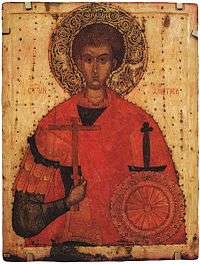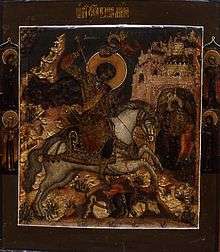Demetrius of Thessaloniki
| Saint Demetrios of Thessaloniki | |
|---|---|
|
12th-century mosaic depicting St Demetrios, from the Golden-Roofed Monastery in Kiev | |
| Great-Martyr, Myrrh-streamer | |
| Born |
270 Sirmium, Roman Empire (now Serbia) |
| Died |
304 (aged 33–34) Sirmium, Roman Empire (now Serbia) |
| Venerated in |
Eastern Orthodox Church Oriental Orthodoxy Roman Catholic |
| Major shrine | Hagios Demetrios, Thessaloniki |
| Feast | 26 October (Orthodox Churches) 9 April (Roman Catholic Church) |
| Attributes | depicted wearing the armour of a Roman soldier, usually carrying a spear, often seated on a red horse |
| Patronage |
Thessaloniki, Siberia, Sremska Mitrovica, Kosovska Mitrovica; soldiers;[1] Crusades (in Roman Catholic tradition);[1] agriculture, peasants and shepherds (in the Greek countryside during Middle Ages)[2] |
Saint Demetrios of Thessaloniki (Greek: Άγιος Δημήτριος της Θεσσαλονίκης) is a Christian martyr of the early 4th century AD.
During the Middle Ages, he came to be revered as one of the most important Orthodox military saints, often paired with Saint George. His feast day is 26 October for Eastern Orthodox Christians following the Gregorian calendar and 8 November for those following the Julian calendar. In the Roman Catholic church he is most commonly called "Demetrios of Sermium" and his memorial falls on 8 October.
Name

The spelling "Demetrius" is a romanization of the ancient Greek pronunciation; the Byzantine and Modern Greek pronunciation is romanized as Dimitrios or Demetrios. See Demetrios for more on the etymology of the name.
In Russian, he is called Димитрий Солунский ([dimitri solunski] 'Dimitri of Saloniki') and was a patron saint of the Rurik dynasty from the late 11th century on. Izyaslav I of Kiev (whose Christian name was Dimitry) founded the first East Slavic monastery dedicated to this saint. The name Dimitry is in common use.
The Bulgarian Orthodox Church reveres St. Demetrios on 26 October as Димитровден (Dimitrovden).
The Romanian Orthodox Church revers St. Demetrios on 26 October as Sf. Dumitru.
The Serbian Orthodox Church reveres St. Demetrios as Димитрије, having a feast of Mitrovdan on 8 November.
The Macedonian Orthodox Church reveres St. Demetrios on 8 November as Митровден (Mitrovden)
He is known among Albanian-speakers in Kosovo as Shmitri, and in Albania as Shën Dhimitri.
He is known in Lebanon as Mar Dimitri or Mitri for short, which is a common name among Christian Lebanese.
He is known in the Coptic Church as "St. Demetrios of Thessalonica". He is venerated in the Coptic Church on 8 November.
Life

The earliest written accounts of his life were compiled in the 9th century, although there are earlier images of him, and the 7th-century Miracles of Saint Demetrios collection. According to these early accounts, Demetrios was born to pious Christian parents in Thessaloniki, Illyricum in 270.[3] The biographies have Demetrios as a young man of senatorial family who was run through with spears in around 306 AD in Thessaloniki, during the Christian persecutions of Diocletian and Galerian, which matches his depiction in the 7th century mosaics.
Veneration of Sainthood

The theory most scholars endorse is the hypothesis put forward by Bollandist Hippolyte Delehaye, that his veneration was transferred from Sirmium[4] when Thessaloniki replaced it as the main military base in the area in 441/442 AD. His very large church in Thessaloniki, the Hagios Demetrios, dates from the mid-5th century.[5] Thessaloniki remained a centre of his veneration, and he is the patron saint of the city.
After the growth of his veneration as saint, the city of Thessaloniki suffered repeated attacks and sieges from the Slavic peoples who moved into the Balkans, and Demetrios was credited with many miraculous interventions to defend the city. Hence later traditions about Demetrius regard him as a soldier in the Roman army, and he came to be regarded as an important military martyr. Unsurprisingly, he was extremely popular in the Middle Ages.
Some scholars believe that for four centuries after his death, St. Demetrios had no physical relics, and in their place an unusual empty shrine called the "ciborium" was built inside Hagios Demetrios. What are still purported to be his remains subsequently appeared in Thessaloniki, but the local archbishop John, who compiled the first book of the Miracles ca. 610, was publicly dismissive of their authenticity.[6] These are now also kept in Hagios Demetrios. According to believers, these relics were ascertained to be genuine after they started emitting a liquid and strong scented myrrh. This gave the saint the epithet "Myrovlētēs" (Greek: Μυροβλήτης, the Myrrh-streamer).[3]
In the Russian Orthodox Church, the Saturday before the Feast of St. Demetrios is a memorial day commemorating the soldiers who fell in the Battle of Kulikovo (1380), under the leadership of St. Demetrius of the Don. This day is known as Demetrius Saturday.[7]
Iconography
St. Demetrios was initially depicted in icons and mosaics as a young man in patterned robes with the distinctive tablion of the senatorial class across his chest. Miraculous military interventions were attributed to him during several attacks on Thessaloniki, and he gradually became thought of as a soldier: a Constantinopolitan ivory of the late 10th century shows him as an infantry soldier (Metropolitan Museum of Art). But an icon of the late 11th century in Saint Catherine's Monastery on Mount Sinai shows him as before, still a civilian. This may be due to iconic depiction customs on how saints are depicted.
Another Sinai icon, of the Crusader period and painted by a French artist working in the Holy Land in the second half of the 12th century, shows what then became the most common depiction. Demetrius, bearded, rather older, and on a dark horse, rides together with St George, unbearded and on a white horse. Both are dressed as cavalrymen. Also, while St. George is often shown spearing a dragon, St. Demetrios is depicted spearing the gladiator Lyaeos, who according to story was responsible for killing many Christians. Lyaeos is commonly depicted below Demetrios and lying supine, having already been defeated; Lyaeos is traditionally drawn much smaller than Demetrios. In traditional hagiography, Demetrios did not directly kill Lyaeos, but rather through his prayers the gladiator was defeated by Demetrius' disciple, Nestor.
A modern Greek iconographic convention depicts Demetrios with the Great White Tower in the background. The anachronistic White Tower acts as a symbolic depiction of the city of Thessaloniki, despite having been built in the 16th century, centuries after his life, and the exact architecture of the older tower that stood at the same site in earlier times is unknown. Again, iconography often depicts saints holding a church or protecting a city.
According to hagiographic legend, as retold by Dimitry of Rostov in particular, Demetrios appeared in 1207 in the camp of Kaloyan of Bulgaria, piercing the pagan king with a lance and so killing him. This scene, known as Чудо о погибели царя Калояна ("the miracle of the destruction of tsar Kaloyan") became a popular element in the iconography of Saint Demetrios. He is shown on horseback piercing the king with his spear, paralleling the icononography (and often shown alongside) of Saint George and the Dragon.
Music
In 1962 the life and martyrdom of Demetrios became the subject of a 90-minute oratorio by Greek Diaspora composer Nicolas Astrinidis. Three parts of the work were premiered at the first Demetria Festival in Thessaloniki on 26 October 1962. The entire oratorio was premiered in 1966 and received subsequent performances in 1985 (Thessaloniki) and in 1993 (Bucharest).[8] All performances have been recorded.[9]
Notes
- 1 2 Roth (1993), p. 36.
- ↑ Kloft (2010), p. 25.
- 1 2 Saint Demetrius Ukrainian Orthodox Cathedral
- ↑ Woods 2000, pp. 223–5
- ↑ "Museum in the Crypt of the Church of St. Demetrios", Macedonian Museums
- ↑ Cormack p. 75
- ↑ Commemorated on October 24
- ↑ Ilias Chrissochoidis, Nicolas Astrinidis: Life - Works catalog, Stanford, 2012. ISBN 1478248637
- ↑ Nicolas Astrinidis, Oratorio Saint Demetrios
See also
- Hagios Demetrios, the main sanctuary dedicated to Saint Demetrios
References
- Roth, Paul W. (1993). Soldatenheilige (in German). Graz, Vienna, Cologne: Verlag Styria. ISBN 3-222-12185-0.
- Kloft, Hans (2010). Mysterienkulte der Antike. Götter, Menschen, Rituale (in German). Munich: C.H. Beck. ISBN 978-3-406-44606-1.
- Robin Cormack, Writing in Gold, Byzantine Society and its Icons, George Philip, London, 1985. ISBN 0-540-01085-5
- Eugenia Russell, St Demetrius of Thessalonica; Cult and Devotion in the Middle Ages, Peter Lang, Oxford, 2010. ISBN 978-3-0343-0181-7
- James C. Skedros, Saint Demetrios of Thessaloniki: Civic Patron and Divine Protector 4th-7th Centuries CE, Trinity Press International, 1999. Summarized in Harvard Theological Review 89:410 (1996). in JSTOR
- James C. Skedros, "Response to David Woods" Harvard Theological Review 93:3:235 (July 2000). at JSTOR
- Kurt Weitzmann in The Icon, 1982, Evans Brothers Ltd, London, ills. pp. 32,51,220 (trans of Le Icone, Montadori 1981), ISBN 0-237-45645-1
- Woods, David (2000). "Thessalonica's Patron: Saint Demetrius or Emeterius?". Harvard Theological Review. 93 (3): 221–234. free copy
- David Woods, bibliography on St. Demetrius
External links
| Wikimedia Commons has media related to Saint Demetrius. |
- David Woods, St Demetrius from his Military Martyrs Web site. Includes article on Origins of the Cult, the Passion and Miracles by Anastasius the Librarian (BHL 2122 and 2123), images & links.
- The Life Of The Holy Great Martyr Of Christ Saint Demetrios The Myrrh-Bearer of Thessalonica Compiled by Fr. Demetrios Serfes
- Holy, Glorious Demetrius the Myrrhgusher of Thessalonica Orthodox icon and synaxarion
